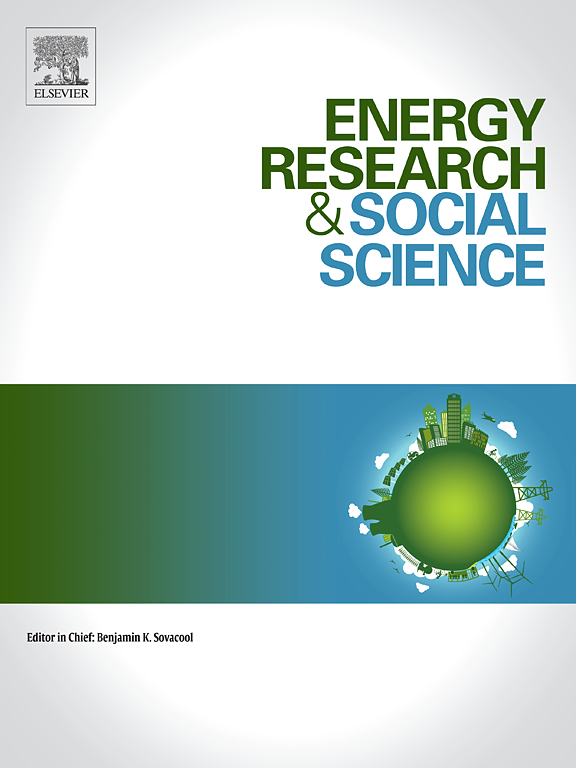What to expect when you're expecting engagement: Delivering procedural justice in large-scale solar energy deployment
IF 7.4
2区 经济学
Q1 ENVIRONMENTAL STUDIES
引用次数: 0
Abstract
Community engagement in the planning process to build large-scale solar (LSS) projects can win local support and advance procedural justice. However, an understanding of community engagement in current LSS development is lacking. Using responses from a U.S. nationwide survey (n = 979) of residential neighbors living within 3 miles (4.8 km) of completed LSS projects (i.e. “solar neighbors”) and project details from the U.S. Large-Scale Solar Photovoltaic Database (USPVDB), this study seeks to answer the following questions: How are solar neighbors' perceptions of community engagement associated with their attitudes toward their LSS projects? How do solar neighbors' perceptions of community engagement compare to their expectations? And, how do neighbors explain what they perceived about the planning process? We answer these questions using mixed methods, including regression modeling, a new gap analysis technique, and qualitative coding. We find that higher perceived engagement is associated with more positive attitudes toward the project, even when controlling for respondents who acted in opposition. Supporters and opponents alike expect more engagement than they perceived and information about projects both before construction and after operation is lacking. Awareness and engagement expectations increase at certain project size and proximity thresholds. However, most neighbors expect the public to offer input during engagement, but not make decisions. We contextualize these findings with explanatory comments from respondents.
当你期待参与时,你会期待什么:在大规模太阳能部署中提供程序公正
社区参与大型太阳能(LSS)项目的规划过程可以赢得当地的支持,促进程序公正。然而,目前缺乏对社区参与LSS发展的理解。利用美国全国范围内居住在完成的LSS项目(即“太阳能邻居”)3英里(4.8公里)内的住宅邻居(n = 979)的调查结果和美国大型太阳能光伏数据库(USPVDB)的项目细节,本研究试图回答以下问题:太阳能邻居对社区参与的看法如何与他们对LSS项目的态度相关联?太阳邻居对社区参与的看法与他们的期望相比如何?邻居们如何解释他们对规划过程的看法?我们使用混合方法来回答这些问题,包括回归建模、一种新的差距分析技术和定性编码。我们发现,更高的感知参与度与对项目更积极的态度有关,即使在控制反对行为的受访者时也是如此。支持者和反对者都期望更多的参与,而有关项目开工前和运营后的信息都缺乏。在特定的项目规模和接近阈值下,意识和参与期望会增加。然而,大多数邻居希望公众在参与过程中提供意见,而不是做出决定。我们将这些发现与受访者的解释性评论联系起来。
本文章由计算机程序翻译,如有差异,请以英文原文为准。
求助全文
约1分钟内获得全文
求助全文
来源期刊

Energy Research & Social Science
ENVIRONMENTAL STUDIES-
CiteScore
14.00
自引率
16.40%
发文量
441
审稿时长
55 days
期刊介绍:
Energy Research & Social Science (ERSS) is a peer-reviewed international journal that publishes original research and review articles examining the relationship between energy systems and society. ERSS covers a range of topics revolving around the intersection of energy technologies, fuels, and resources on one side and social processes and influences - including communities of energy users, people affected by energy production, social institutions, customs, traditions, behaviors, and policies - on the other. Put another way, ERSS investigates the social system surrounding energy technology and hardware. ERSS is relevant for energy practitioners, researchers interested in the social aspects of energy production or use, and policymakers.
Energy Research & Social Science (ERSS) provides an interdisciplinary forum to discuss how social and technical issues related to energy production and consumption interact. Energy production, distribution, and consumption all have both technical and human components, and the latter involves the human causes and consequences of energy-related activities and processes as well as social structures that shape how people interact with energy systems. Energy analysis, therefore, needs to look beyond the dimensions of technology and economics to include these social and human elements.
 求助内容:
求助内容: 应助结果提醒方式:
应助结果提醒方式:


